Choose the pair of terms that completes this sentence about functional groups in organic chemistry: Carboxyl is to __________ as __________ is to base.
- sulfhydryl; carbonyl
- hydroxyl; amino
- acid; amino
- ketone; phosphate
- acid; carbonyl
acid; amino
Ex.
Choose the pair of terms that completes this sentence about functional groups in organic chemistry: Carboxyl is to acid as amino is to base.
The carboxyl group is an acid and the amino group is a base. A carboxyl group has acidic properties because it can donate a proton (H+) to a solution because the covalent bond between oxygen and hydrogen is so polar.
The amino group acts as a base because it can pick up or accept a proton (H+) from a solution. In this way, they can be viewed as complementary because one, the acid, donates a proton and the other, the base, accepts a proton.
This same complementary pattern does not exist for the other answer choices.
Carbon’s atomic number is 6. This means that it has __________ electrons. After completing the first energy level, carbon has __________ valence electrons and can form __________ bonds.
- 6; 4; 4
- 12; 4; 4
- 12; 6; 6
- 4; 4; 4
- 6; 2; 2
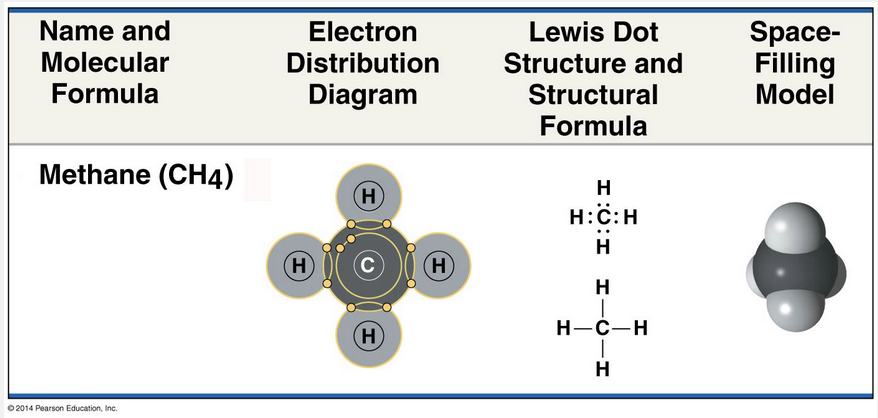
6; 4; 4
Ex.
Carbon’s atomic number is 6. This means that it has 6 electrons. After completing the first energy level, carbon has 4 valence electrons and can form 4 bonds.
Carbon has 6 electrons, with 2 in the first electron shell and 4 in the second shell; thus, it has 4 valence electrons in a shell that can hold up to 8 electrons. A carbon atom usually completes its valence shell by sharing its 4 electrons with other atoms so that 8 electrons are present. Each pair of shared electrons constitutes a covalent bond. In organic molecules, carbon usually forms single or double covalent bonds. Each carbon atom acts as an intersection point from which a molecule can branch off in as many as four directions. This enables carbon to form large, complex molecules.
“4; 4; 4”; “6; 2; 2”; “12; 6; 6”; and “12; 4; 4” are incorrect because carbon has 6 electrons, with 2 in the first electron shell and 4 in the second shell; thus, it has 4 valence electrons in a shell that can hold up to 8 electrons.
Which of the following molecules is a weak acid?
- R-OH
- R-NH2
- R-COOH
- None of the listed responses is correct.
- R-SH
R-COOH
Ex.
The R-COOH molecule is a weak acid.
The molecule with the carboxyl group (-COOH) is a weak acid because it can donate a proton (H+) as a result of the covalent bond between oxygen and hydrogen being so polar. The amino (-NH2), sulfhydryl (-SH), and hydroxyl (-OH) groups cannot donate protons (H+).
Biologically important chemical groups include all of the following except __________.
- phosphate group (-PO3–2)
- amine group (-NH2)
- sulfhydryl group (-SH)
- water (H2O)
- carboxyl group (-COOH)
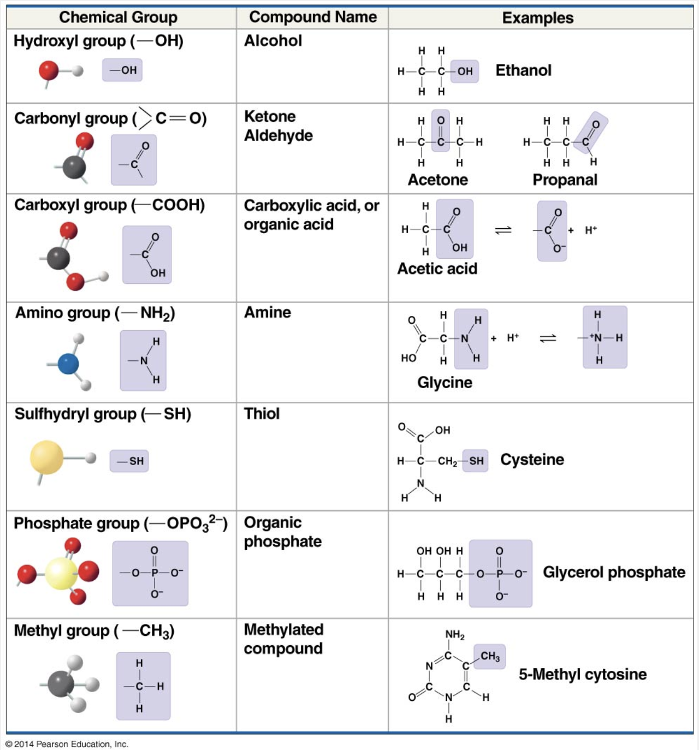
water (H2O)
Ex.
Biologically important chemical groups include all of the following except water (H2O).
The seven chemical groups most important in biological processes are the hydroxyl, carbonyl, carboxyl, amino, sulfhydryl, phosphate, and methyl groups. The first six groups can be chemically reactive; of these, all except the sulfhydryl group are also hydrophilic and thus increase the solubility of organic compounds in water. The methyl group is not reactive but instead often serves as a recognizable tag on biological molecules. Study the figure below to become familiar with these biologically important chemical groups.
“Carboxyl group (-COOH),” “amine group (-NH2),” “sulfhydryl group (-SH),” and “phosphate group (-PO3 –2)” are four of the seven chemical groups most important in biological processes. Since this is an except question, all of these answers are incorrect.
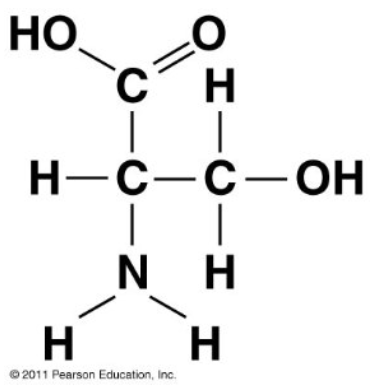
Which functional group is not present in this molecule?
- Carboxyl
- Hydroxyl
- Sulfhydryl
- Amino

Sulfhydryl
Ex.
The sulfhydryl is the functional group not present in this molecule.
The sulfhydryl group (-SH) consists of a sulfur atom bonded to an atom of hydrogen and resembles a hydroxyl group in shape.
Carboxyl, hydroxyl, and amino groups are all present in the depicted molecule.
Molecules that contain only carbon and hydrogen are __________.
- found only as linear chains
- called hydrocarbons
- called hydrated carbons
- called inorganic carbons
- None of the listed responses are correct.
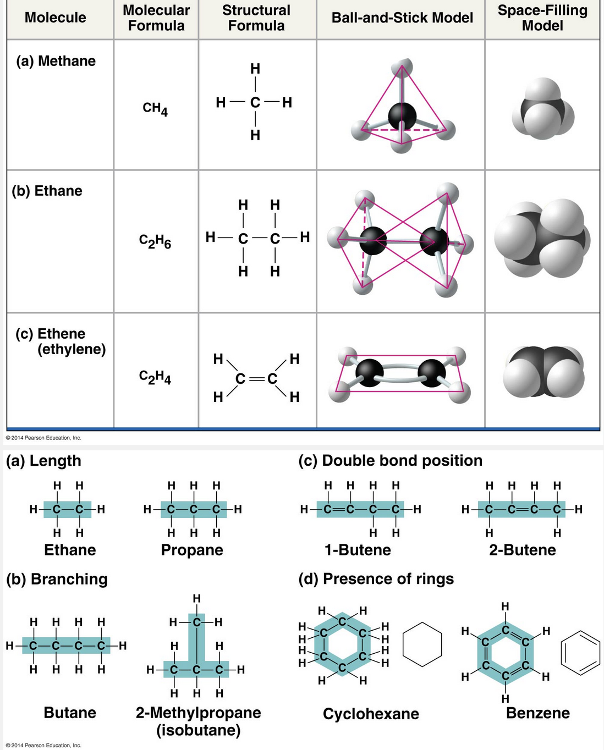
called hydrocarbons
Ex.
Molecules that contain only carbon and hydrogen are called hydrocarbons.
All of the molecules that are shown in the two figures below are hydrocarbons, organic molecules consisting of only carbon and hydrogen. Atoms of hydrogen are attached to the carbon skeleton wherever electrons are available for covalent bonding. Hydrocarbons are the major components of petroleum, which is called a fossil fuel because it consists of the partially decomposed remains of organisms that lived millions of years ago. Although hydrocarbons are not prevalent in most living organisms, many of a cell’s organic molecules have regions consisting of only carbon and hydrogen.
“Called hydrated carbons” is incorrect because the molecules contain hydrogen, carbon, and oxygen.
“Called inorganic carbons” is incorrect because any molecule that contains carbon and hydrogen is organic.
“Found only as linear chains” is incorrect because the molecules can be branched, have double bonds, and form rings.
In the pharmaceutical industry, two enantiomers of a drug __________.
- are always produced as a mixture
- never counteract each other
- are equally safe in either form
- are equally effective
- may not be equally effective
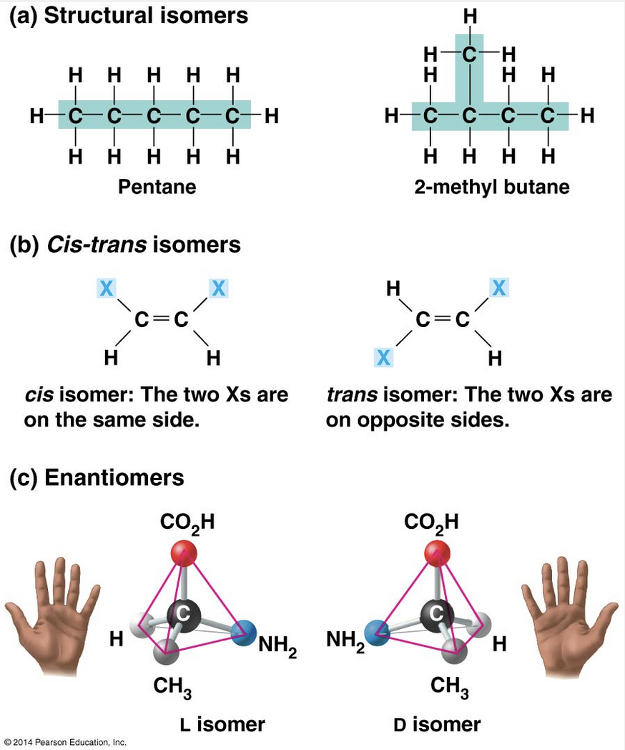
may not be equally effective
Ex.
In the pharmaceutical industry, two enantiomers of a drug may not be equally effective.
The concept of enantiomers is important in the pharmaceutical industry because the two enantiomers of a drug may not be equally effective, as is the case for both ibuprofen and the asthma medication albuterol. Methamphetamine also occurs in two enantiomers that have very different effects. One enantiomer is the highly addictive stimulant drug known as “crank,” sold illegally in the street drug trade. The other has a much weaker effect and is the active ingredient in an over-the-counter vapor inhaler for the treatment of nasal congestion. The differing effects of enantiomers in the body demonstrate that organisms are sensitive to even the most subtle variations in molecular architecture. Once again, we see that molecules have emergent properties that depend on the specific arrangement of their atoms.
“Are always produced as a mixture” is incorrect because in some cases, an enantiomer may be highly addictive or it may counteract the active form, as in albuterol.
“Are equally effective” is incorrect because usually, only one isomer is biologically active because only that form can bind to specific molecules in an organism.
“Never counteract each other” is incorrect because as in the case of albuterol, only the R form is synthesized and sold because the S form counteracts the active R form.
“Are equally safe in either form” is incorrect because some enantiomers can be highly addictive drugs.
The chemical group that is involved in regulating DNA is the __________.
- sulfhydryl group (-SH)
- phosphate group (-PO3–2)
- carboxyl group (-COOH)
- methyl group (-CH3)
- amine group (-NH2)

methyl group (-CH3)
Ex.
The chemical group that is involved in regulating DNA is the methyl group (-CH3) because it affects the expression of genes when on DNA or on proteins bound to DNA.
“Amine group (-NH2)” is incorrect because this group acts as a base and can remove an H+ from the surrounding solution.
“Sulfhydryl group (-SH)” is incorrect because two -SH groups can react, forming a “cross-link” that helps stabilize protein structure.
“Phosphate group (-PO3 –2)” is incorrect because it contributes negative charge (1– when positioned inside a chain of phosphates; 2– when at the end). When attached, it confers on a molecule the ability to react with water, releasing energy.
“Carboxyl group (-COOH)” is incorrect because it acts as an acid (can donate H+) because the covalent bond between oxygen and hydrogen is so polar.
In Miller’s 1953 laboratory experiment, __________.
- abiotic compounds cycled through the apparatus and were sampled for organic compounds
- organic compounds were added to the seawater and decomposed
- the experiment was not useful in supporting evolution
- condensed molecules never contained organic compounds
- the atmosphere in the experiment contained O2
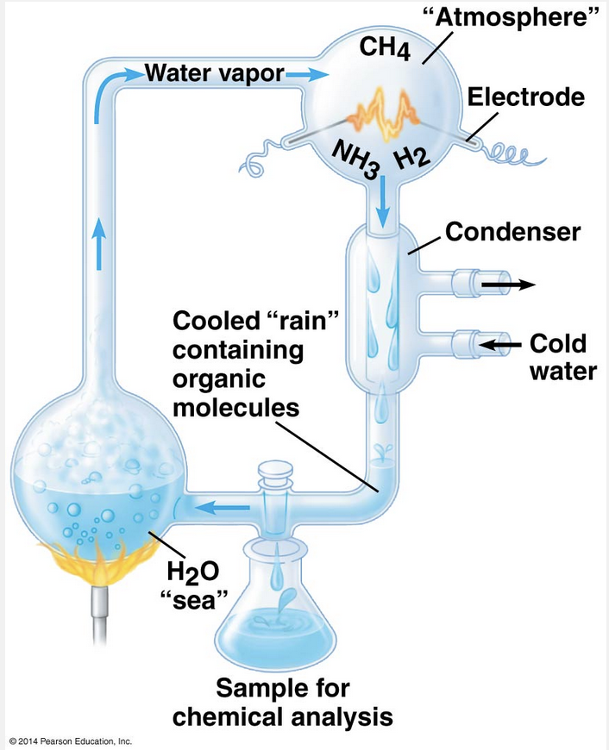
abiotic compounds cycled through the apparatus and were sampled for organic compounds
Ex.
In Miller’s 1953 laboratory experiment, abiotic compounds cycled through the apparatus and were sampled for organic compounds.
In 1953, Stanley Miller, a graduate student of Harold Urey’s at the University of Chicago, helped bring the abiotic (nonliving) synthesis of organic compounds into the context of evolution. From his results, Miller concluded that complex organic molecules could arise spontaneously under conditions thought at that time to have existed on the early Earth. These experiments supported the idea that abiotic synthesis of organic compounds, perhaps near volcanoes, could have been an early stage in the origin of life.
“Organic compounds were added to the seawater and decomposed” is incorrect because abiotic molecules were added to the seawater in the initial step.
“Condensed molecules never contained organic compounds” is incorrect because the condensed “cooled rain” contained organic molecules.
“The experiment was not useful in supporting evolution” is incorrect because although the jury is still out, these experiments do support the idea of abiotic synthesis of organic compounds.
“The atmosphere in the experiment contained O2” is incorrect because the atmosphere contained a mixture of ammonia, methane, and hydrogen gas.
Pharmaceutical companies are selling close to $200 billion worth of single-enantiomer drugs. Why might it be important to use only one form of an enantiomer?
- It is not important. Both enantiomers constantly flip from right-handed to left-handed.
- One enantiomer may provide an effective treatment whereas the other may be ineffective or even toxic.
- It is cheaper to manufacture only one of the enantiomers.
- It is not important. Both enantiomers will be equally effective.
- The left-handed version of the enantiomer is always the effective one.
One enantiomer may provide an effective treatment whereas the other may be ineffective or even toxic.
Ex.
One enantiomer may provide an effective treatment whereas the other may be ineffective or even toxic.
It is important for pharmaceutical companies to sell only single-enantiomer drugs because two enantiomers of a drug may not be equally effective. For example, both ibuprofen and the asthma medication albuterol have different pharmaceutical behaviors. In addition, methamphetamine also occurs in two enantiomers that have very different effects. One enantiomer is the highly addictive stimulant drug known as “crank,” sold illegally in the street drug trade. The other has a much weaker effect and is even found as an ingredient in an over-the-counter vapor inhaler for treatment of nasal congestion. It is expensive to manufacture these single-enantiomer drugs but it is important because only one or the other of the isomers, although occasionally both, will be safe. It is also important to understand if the enantiomers spontaneously flit between forms, which can but doesn’t always happen in the body.
Stanley Miller's experiments were significant because he demonstrated that __________.
- the behavior of any molecule containing a carbon atom was fundamentally the same
- urea could be synthesized from entirely naturally occurring salts
- under certain circumstances the theory of vitalism was valid
- lightning discharges could produce the molecules previously presumed to have originated in volcanic outgassings
- a variety of simple organic compounds could be spontaneously synthesized from components in Earth's primitive atmosphere
a variety of simple organic compounds could be spontaneously synthesized from components in Earth's primitive atmosphere
Ex.
Stanley Miller's experiments were significant because he demonstrated that a variety of simple organic compounds could be spontaneously synthesized from components in Earth's primitive atmosphere.
Stanley Miller's experiments were significant because he showed that complex organic molecules, not volcanic outgassings, could arise spontaneously under conditions thought to have existed on the early Earth. His work helped bring the abiotic (nonliving) synthesis of organic compounds into the context of evolution and to shift the mainstream of biological thought from vitalism to mechanism, the view that physical and chemical laws govern all natural phenomena. Earlier work by Friedrich Wöhler showed that urea could be synthesized in the lab.
The carbon skeleton can vary in all of the following except __________.
- length
- double bond position
- presence of rings
- branching
- lacking hydrogen atoms
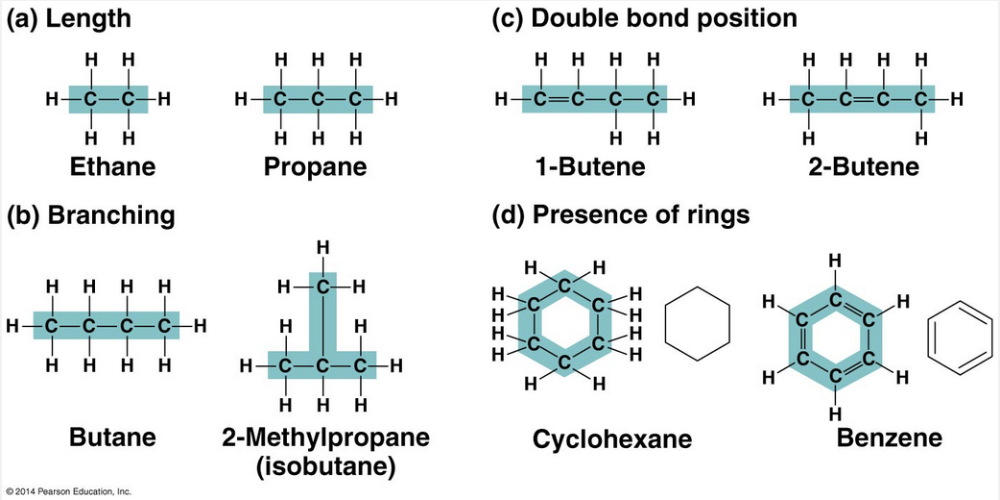
lacking hydrogen atoms
Ex.
The carbon skeleton can vary in all of the following except lacking hydrogen atoms.
Carbon chains form the skeletons of most organic molecules. The skeletons vary in length and may be straight, branched, or arranged in closed rings. Some carbon skeletons have double bonds, which vary in number and location. Such variation in carbon skeletons is one important source of the molecular complexity and diversity that characterize living matter. In addition, atoms of other elements can be bonded to the skeletons at available sites.
“Length,” “branching,” “double bond position,” and “presence of rings” are all characteristics of the carbon skeleton and therefore are incorrect answers because this is an except question.
Which of the following is found in all amino acids?
- -COOH
- -NH2
- -OH
- -COH
- Both -COOH and -NH2
Both -COOH and -NH2
Ex.
Both -COOH and -NH2 are found in all amino acids.
All amino acids contain at least one carboxyl functional group and one amino functional group. In addition, it may contain one or more of the other functional groups.
Enantiomers are __________.
- mirror-image isomers of a molecule
- cis-trans isomers of a molecule
- structural isomers of a molecule
- molecules that can be tightly packed because they are unsaturated
- not important in drug development

mirror-image isomers of a molecule
Ex.
Enantiomers are mirror-image isomers of a molecule.
Enantiomers are isomers that are mirror images of each other and that differ in shape due to the presence of an asymmetric carbon, one that is attached to four different atoms or groups of atoms. The four groups can be arranged in space around the asymmetric carbon in two different ways that are mirror images. Enantiomers are, in a way, left-handed and right-handed versions of the molecule. Just as your right hand won’t fit into a left-handed glove, a “right-handed” molecule won’t fit into the same space as the “left-handed” version. Usually, only one isomer is biologically active because only that isomer can bind to specific molecules in an organism.
“Structural isomers of a molecule” is incorrect because structural isomers have different covalent arrangement of their atoms.
“Cis-trans isomers of a molecule” is incorrect because in this case, the carbons have covalent bonds to the same atoms, but these atoms differ in their spatial arrangements due to the inflexibility of double bonds.
“Molecules that can be tightly packed because they are unsaturated” is incorrect because unsaturated molecules cannot be tightly packed and also exist as liquids.
“Not important in drug development” is incorrect because the two enantiomers of a drug may not be equally effective.
What is ATP's importance in the cell?
- ATP contains a long hydrocarbon tail and is important in storing energy.
- ATP can add phosphate groups, thereby releasing energy that can be used in cellular processes.
- ATP stores the potential to react with water, thereby removing a phosphate group and releasing energy for cellular processes.
- ATP is an important component of cell membranes because it is nonpolar and hydrophobic.
- ATP stores energy in carbonyl groups. When a carbonyl group is removed, energy is released to be used in cellular processes.
ATP stores the potential to react with water, thereby removing a phosphate group and releasing energy for cellular processes.
Ex.
ATP stores the potential to react with water, thereby removing a phosphate group and releasing energy for cellular processes.
ATP (adenosine triphosphate) is important to the cell because it can react with water, forming inorganic phosphate and ADP (adenosine diphosphate). This reaction releases energy that can be used by the cell. ATP consists of an organic molecule called adenosine attached to a string of three phosphate groups. Where three phosphates are present in series, as in ATP, one phosphate may be split off as a result of a reaction with water.
Although ATP is sometimes said to store energy, it is more accurate to think of it as storing the potential to react with water.
ATP does not have a long hydrocarbon tail. It is a relatively small molecule that easily moves through the cell and across the cell membrane, but it is not a component of cell membranes.
What are the six most important chemical elements of life?
- Carbon, nitrogen, oxygen, calcium, phosphate, and hydrogen
- Carbon, nitrogen, oxygen, hydrogen, phosphate, and sulfur
- Carbon, nitrogen, calcium, oxygen, phosphate, and iron
- Carbon, nitrogen, calcium, zinc, iron, and hydrogen
- Carbon, nitrogen, sulfur, hydrogen, iron, and magnesium
Carbon, nitrogen, oxygen, hydrogen, phosphate, and sulfur
Ex.
The six most important chemical elements of life are carbon, nitrogen, oxygen, hydrogen, phosphate, and sulfur.
Of these chemical elements, carbon is unparalleled in its ability to form molecules that are large, complex, and varied, making possible the diversity of organisms that have evolved on Earth. Proteins, DNA, carbohydrates, and other molecules that distinguish living matter from inanimate material are all composed of carbon atoms bonded to one another and to atoms of these other elements. These elements all form strong covalent bonds, an essential characteristic in the architecture of complex organic molecules. Elements such as iron (Fe), calcium (Ca), magnesium (Mg), and zinc (Zn), although important to life, are readily available in the environment and serve specialized rather than central roles in the formation of complex, life-dependent molecules.
Which chemical group is most likely to be responsible for an organic molecule behaving as a base?
- Phosphate
- Carbonyl
- Amino
- Carboxyl
- Hydroxyl
Amino
Ex.
The chemical group that is most likely to be responsible for an organic molecule behaving as a base is the amino group (-NH2) because it acts as a base and can pick up a proton (H+) from the surrounding solution (water, in living organisms). It consists of a nitrogen atom bonded to two hydrogen atoms and to the carbon skeleton.
Hydroxyl, carboxyl, carbonyl, and phosphate groups do not accept protons.
Which element is always associated with organic chemistry?
- Sulfur
- Hydrogen
- Nitrogen
- Carbon
- Oxygen
Carbon
Ex.
The element that is always associated with organic chemistry is carbon.
Most, but not all, organic compounds also contain hydrogen atoms in addition to carbon.
Sulfur, nitrogen, hydrogen, and oxygen are also common in organic compounds, but they are not always present.
The chemical group that acts as an acid is the __________.
- sulfhydryl group (-SH)
- amine group (-NH2)
- methyl group (-CH3)
- carboxyl group (-COOH)
- phosphate group (-PO3–2)

carboxyl group (-COOH)
Ex.
The chemical group that acts as an acid is the carboxyl group (-COOH). It acts as an acid (can donate H+) because the covalent bond between oxygen and hydrogen is so polar.
“Amine group (-NH2)” is incorrect because this group acts as a base and can remove an H+ from the surrounding solution.
“Sulfhydryl group (-SH)” is incorrect because two -SH groups can react, forming a “cross-link” that helps stabilize protein structure.
“Phosphate group (-PO3 –2)” is incorrect because it contributes a negative charge (1- when positioned inside a chain of phosphates; 2- when at the end). When attached, it confers on a molecule the ability to react with water, releasing energy.
“Methyl group (-CH3)” is incorrect because it affects the expression of genes when on DNA or on proteins bound to DNA. It also affects the shape and function of male and female sex hormones.
When a double bond joins two carbon atoms, __________ can form.
- structural isomers
- enantiomers
- cis-trans isomers
- saturated fats
- chemical groups

cis-trans isomers
Ex.
When a double bond joins two carbon atoms, cis-trans isomers can form. In cis-trans isomers (formerly called geometric isomers), carbons have covalent bonds to the same atoms, but these atoms differ in their spatial arrangements due to the inflexibility of double bonds. Single bonds allow the atoms they join to rotate freely about the bond axis without changing the compound. In contrast, double bonds do not permit such rotation. If a double bond joins two carbon atoms and each C also has two different atoms (or groups of atoms) attached to it, then two distinct cis-trans isomers are possible. Consider a simple molecule with two double-bonded carbons, each of which has an H and an X attached to it. The arrangement with both Xs on the same side of the double bond is called a cis isomer, and that with the Xs on opposite sides is called a trans isomer. The subtle difference in shape between such isomers can dramatically affect the biological activities of organic molecules. For example, the biochemistry of vision involves a light-induced change of retinal, a chemical compound in the eye, from the cis isomer to the trans isomer.
“Structural isomers” is incorrect because these isomers have different covalent arrangements of their atoms.
“Enantiomers” is incorrect because these are mirror images of a molecule.
“Saturated fats” is incorrect because saturated hydrocarbons do not have double bonds.
“Chemical groups” is incorrect because they contribute to the molecular shape of a molecule and its unique properties.
Which of the following molecules is a weak base?
- None of the listed responses is correct.
- R-SH
- R-COOH
- R-NH2
- R-OH
R-NH2
Ex.
The molecule R-NH2 is a weak base.
The molecule with the amino group (-NH2) is a weak base because it can accept a proton (H+) from the surrounding solution (water in living organisms), which is the behavior of a base. The hydroxyl group (-OH) cannot accept a proton, and the carboxyl group (-COOH) can donate but not accept a proton.
Which of the following are properties of hydrocarbons?
- Hydrophilic, containing numerous carboxyl groups, and nonpolar
- Hydrophilic, a good source of stored energy, and consisting primarily of carbon and hydrogen
- Hydrophobic, nonpolar, and a good source of stored energy
- Hydrophobic, containing numerous amine groups, and polar
- Hydrophobic, polar, and charged
Hydrophobic, nonpolar, and a good source of stored energy
Ex.
Hydrocarbons are organic molecules consisting of only carbon and hydrogen. Their properties include being hydrophobic, nonpolar, and a good source of stored energy.
They are not charged and do not contain functional groups, such as carboxyl and amine groups, like many other organic compounds. Hydrocarbons are hydrophobic because the great majority of their bonds are relatively nonpolar carbon-to-hydrogen linkages. They can undergo reactions that release a relatively large amount of energy. The gasoline that fuels a car consists of hydrocarbons, and the hydrocarbon tails of fats serve as stored fuel for animals. They are the major components of petroleum, which is called a fossil fuel because it consists of the partially decomposed remains of organisms that lived millions of years ago.
When three phosphate groups are covalently attached to adenosine, __________ is formed.
- AMP
- Pi
- ATP
- ADP
- glycerol phosphate
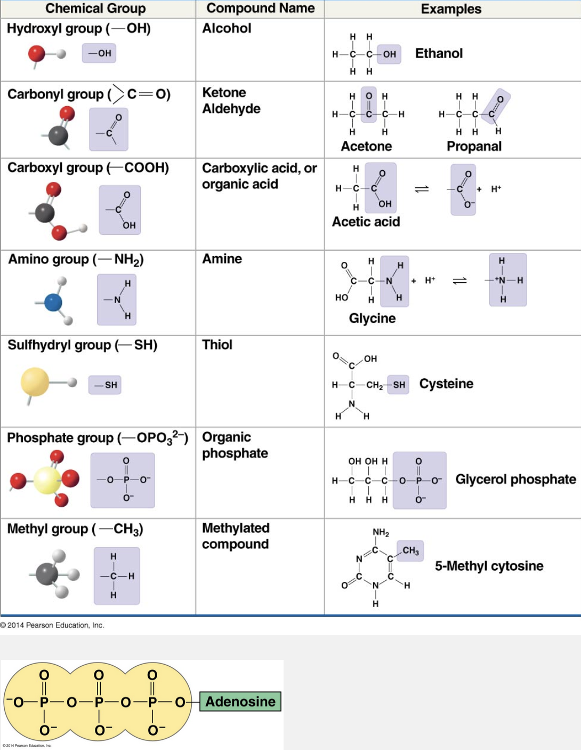
ATP
Ex.
When three phosphate groups are covalently attached to adenosine, ATP is formed.
The “Phosphate group” row in the chemical groups figure below shows a simple example of an organic phosphate molecule. A more complicated organic phosphate, adenosine triphosphate, or ATP, is worth mentioning here because its function in a cell is so important. ATP consists of an organic molecule called adenosine attached to a string of three phosphate groups: Where three phosphates are present in a series, as in ATP, one phosphate may be split off as a result of a reaction with water. This inorganic phosphate ion, HOPO3 2–, is often abbreviated Pi in this book, and a phosphate group in an inorganic molecule is often written as Pi. Having lost one phosphate, ATP becomes adenosine diphosphate, or ADP. Although ATP is sometimes said to store energy, it is more accurate to think of it as storing the potential to react with water. This reaction releases energy that can be used by a cell.
“ADP” is incorrect because it has only two phosphate groups and is adenosine diphosphate.
“AMP” is incorrect because it has only one phosphate group and is adenosine monophosphate.
“Pi” is incorrect because it is an inorganic phosphate.
“Glycerol phosphate” is incorrect because it is not adenosine triphosphate (ATP).
Inorganic carbon such as CO2 differs from organic carbon because __________.
- None of the listed responses is correct.
- CO2 is an example of an organic molecule
- inorganic carbon always has a hydrogen atom covalently attached to it
- organic carbon always has a hydrogen atom covalently attached to it
- inorganic carbon always has double bonds and organic carbon never has double bonds
organic carbon always has a hydrogen atom covalently attached to it
Ex.
Inorganic carbon such as CO2 differs from organic carbon because organic carbon always has a hydrogen atom covalently attached to it.
In the carbon dioxide molecule (CO2), a single carbon atom is joined to two atoms of oxygen by double covalent bonds. The structural formula for CO2 is shown here: O=C=O. Each line in a structural formula represents a pair of shared electrons. Thus, the two double bonds in CO2 have the same number of shared electrons as four single bonds. The arrangement completes the valence shells of all atoms in the molecule. Because CO2 is a very simple molecule and lacks hydrogen, it is often considered inorganic even though it contains carbon. Whether we call CO2 organic or inorganic, however, it is clearly important to the living world as the source of carbon for all organic molecules in organisms.
“Inorganic carbon always has double bonds and organic carbon never has double bonds” is incorrect because both inorganic and organic carbon can form double bonds.
“Inorganic carbon always has a hydrogen atom covalently attached to it” is incorrect because inorganic carbon lacks hydrogen atoms.
“CO2 is an example of an organic molecule” is incorrect because carbon dioxide lacks hydrogen atoms and is classified as an inorganic form of carbon.
Chemical groups are significant because __________.
- they stabilize a molecule by preventing chemical reactions
- they contribute to the molecular shape of a molecule and its unique properties
- they are always the same and do not influence the properties of a molecule
- None of the listed responses is correct.
- they can never be substituted
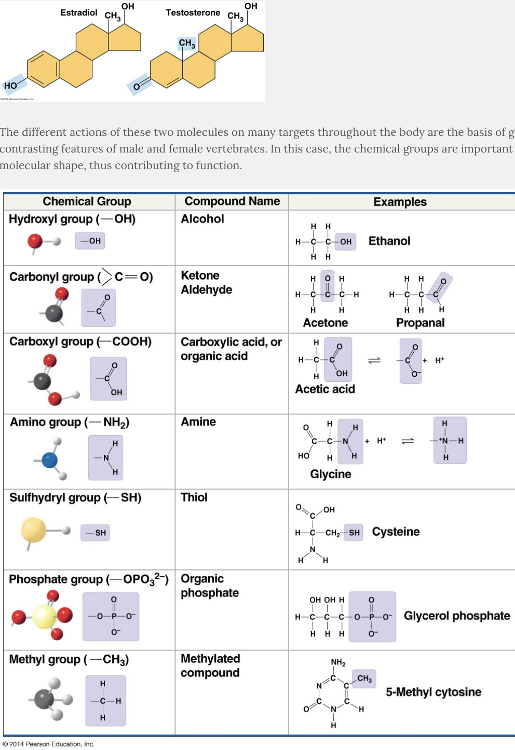
they contribute to the molecular shape of a molecule and its unique properties
Ex.
Chemical groups are significant because they contribute to the molecular shape of a molecule and its unique properties.
The properties of an organic molecule depend not only on the arrangement of its carbon skeleton but also on the chemical groups attached to that skeleton. We can think of hydrocarbons, the simplest organic molecules, as the underlying framework for more complex organic molecules. A number of chemical groups can replace one or more hydrogen molecules of the hydrocarbon. These groups may participate in chemical reactions or may indirectly contribute to function by their effects on molecular shape; they help give each molecule its unique properties. Consider the differences between estradiol (a type of estrogen) and testosterone. These compounds are female and male sex hormones, respectively, in humans and other vertebrates. Both are steroids, organic molecules with a common carbon skeleton in the form of four fused rings. They differ only in the chemical groups attached to the rings (shown here in abbreviated form); the distinctions in molecular architecture are shaded in blue:
The different actions of these two molecules on many targets throughout the body are the basis of gender, producing the contrasting features of male and female vertebrates. In this case, the chemical groups are important because they affect molecular shape, thus contributing to function.
“They are always the same and do not influence the properties of a molecule” is incorrect because each chemical group contributes to the unique properties of a molecule.
“They can never be substituted” is incorrect because substitution of chemical groups contributes to the unique properties of a molecule.
“They stabilize a molecule by preventing chemical reactions” is incorrect because when chemical groups are involved in chemical reactions, they are called functional groups.
Although the structures of the functional groups that are most important to life vary, they share one thing in common: They __________.
- all have at least one double bond
- force straight chains of carbons into closed rings of carbon
- all contain oxygen
- always cause the carbon to which they are attached to become an asymmetric carbon, thus converting the molecule into an enantiomer
- all help give each biological molecule its unique properties
all help give each biological molecule its unique properties
Ex.
Although the structures of the functional groups that are most important to life vary, they share one thing in common: They all help give each biological molecule its unique properties.
The seven chemical groups most important in biological processes are the hydroxyl, carbonyl, carboxyl, amino, sulfhydryl, phosphate, and methyl groups. The first six groups can be chemically reactive; of these six, all except the sulfhydryl group are also hydrophilic and thus increase the solubility of organic compounds in water. The methyl group is not reactive, but instead often serves as a recognizable tag on biological molecules.
They do not all contain oxygen and they do not all have double bonds.
In addition, their reactive nature does not force straight-chain hydrocarbons into rings or cause a bonded carbon to be asymmetric, which is a property of the molecule and not the attached functional group.
The carbon atom is tetravalent; this means that __________.
- carbon has a total of four electrons
- a carbon atom can complete its valence shell by forming four covalent bonds
- carbon's first electron shell holds four electrons
- carbon readily forms ionic bonds
- the bond angle between each bond is 90°, forming an arrangement like the points on a compass
a carbon atom can complete its valence shell by forming four covalent bonds
Ex.
The carbon atom is tetravalent; this means that a carbon atom can complete its valence shell by forming four covalent bonds.
Carbon possesses a total of six electrons, two in its inner shell and four in its valence (outer) shell and is called tetravalent, which means that it can form four covalent bonds with other atoms or groups of atoms to complete its outer shell of eight. Carbon, with a valence of four, can bond to various other atoms but especially to other carbon atoms, forming the carbon skeletons of organic compounds.
It forms a tetrahedron shape when it bonds with four other atoms.
Carbon is unlikely to form ionic bonds, which would require it to lose or gain an electron.
Pharmaceutical companies are selling close to $200 billion worth of single-enantiomer drugs. Why might it be important to use only one form of an enantiomer?
- It is not important. Both enantiomers constantly flip from right-handed to left-handed.
- It is cheaper to manufacture only one of the enantiomers.
- One enantiomer may provide an effective treatment whereas the other may be ineffective or even toxic.
- The left-handed version of the enantiomer is always the effective one.
- It is not important. Both enantiomers will be equally effective.
One enantiomer may provide an effective treatment whereas the other may be ineffective or even toxic.
Ex.
One enantiomer may provide an effective treatment whereas the other may be ineffective or even toxic.
It is important for pharmaceutical companies to sell only single-enantiomer drugs because two enantiomers of a drug may not be equally effective. For example, both ibuprofen and the asthma medication albuterol have different pharmaceutical behaviors. In addition, methamphetamine also occurs in two enantiomers that have very different effects. One enantiomer is the highly addictive stimulant drug known as “crank,” sold illegally in the street drug trade. The other has a much weaker effect and is even found as an ingredient in an over-the-counter vapor inhaler for treatment of nasal congestion. It is expensive to manufacture these single-enantiomer drugs but it is important because only one or the other of the isomers, although occasionally both, will be safe. It is also important to understand if the enantiomers spontaneously flit between forms, which can but doesn’t always happen in the body.
The chemical group that helps stabilize protein structure is the __________.
- amine group (-NH2)
- sulfhydryl group (-SH)
- methyl group (-CH3)
- phosphate group (-PO3–2)
- carboxyl group (-COOH)

sulfhydryl group (-SH)
Ex.
The chemical group that helps stabilize protein structure is the sulfhydryl group (-SH).
Two -SH groups can react, forming a “cross-link” that helps stabilize protein structure. Hair protein cross-links maintain the straightness or curliness of hair; in hair salons, permanent treatments break cross-links and then re-form them while the hair is in the desired shape.
“Carboxyl group (-COOH)” is incorrect because the group acts as an acid and can donate an H+ to the surrounding solution.
“Amine group (-NH2)” is incorrect because this group acts as a base and can remove an H+ from the surrounding solution.
“Phosphate group (-PO3 –2)” is incorrect because it contributes negative charge (1– when positioned inside a chain of phosphates; 2– when at the end). When attached, this group confers on a molecule the ability to react with water, releasing energy.
“Methyl group (-CH3)” is incorrect because it affects the expression of genes when on DNA or on proteins bound to DNA. It also affects the shape and function of male and female sex hormones.
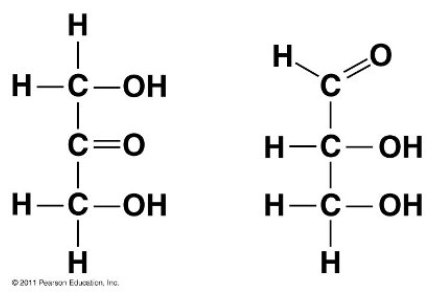
Choose the term that correctly describes the relationship between these two sugar molecules:
- Structural isomers
- Isotopes
- Cis-trans isomers
- Enantiomers

Structural isomers
Ex.
The term that correctly describes the relationship between these two sugar molecules is structural isomer because they differ in the covalent arrangements of their atoms. Structural isomers may also differ in the location of double bonds.
In contrast, cis-trans isomers (formerly called geometric isomers), have covalent bonds to the same atoms, but these atoms differ in their spatial arrangements due to the inflexibility of double bonds.
Enantiomers are isomers that are mirror images of each other and that differ in shape due to the presence of an asymmetric carbon, one that is attached to four different atoms or groups of atoms.
Finally, the same element may for different isotopes when it has the same number of protons but different numbers of neutrons.
Structural isomers have __________.
- left- and right-handed forms
- the same molecular formula but different covalent arrangements of their carbon skeletons
- different functional groups
- the same molecular formula and the same covalent arrangement of their carbon skeletons
- a different molecular formula and the same covalent arrangement of their carbon skeletons

the same molecular formula but different covalent arrangements of their carbon skeletons
Ex.
Structural isomers have the same molecular formula but different covalent arrangements of their carbon skeletons.
Structural isomers differ in the covalent arrangements of their atoms. Compare, for example, the two five-carbon compounds in shown in part a of the figure below. Both have the molecular formula C5H12, but they differ in the covalent arrangement of their carbon skeletons. The skeleton is straight in one compound but branched in the other. The number of possible isomers increases tremendously as carbon skeletons increase in size. There are only three forms of C5H12, but there are 18 variations of C8H18 and 366,319 possible structural isomers of C20H42. Structural isomers may also differ in the location of double bonds.
“A different molecular formula and the same covalent arrangement of their carbon skeletons” and “the same molecular formula and the same covalent arrangement of their carbon skeletons” are incorrect because structural isomers have the same molecular formula but differ in the covalent arrangements of their carbon skeletons.
“Different functional groups” is incorrect because the groups would result in different chemical formulas.
“Left- and right-handed forms” is incorrect because this describes an enantiomer.